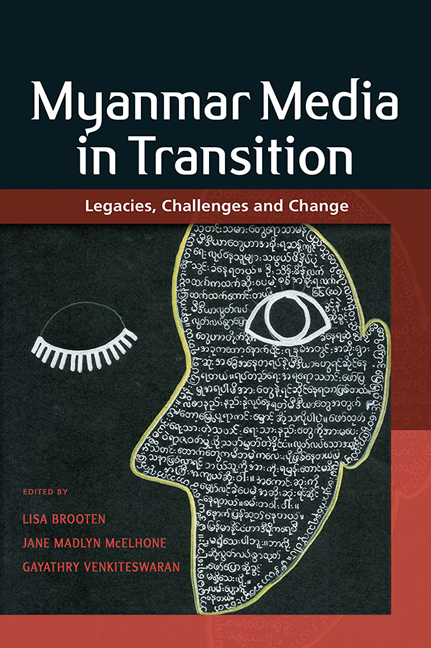Book contents
- Frontmatter
- Contents
- Contributors and Editors
- Burma or Myanmar? A Note on Terminology
- 1 Introduction: Myanmar Media Historically and the Challenges of Transition
- Part I Structural Constraints and Opportunities
- Part II Journalism in Transition
- 6 Silencing a Snakehead Fish: A Case Study in Local Media, Rural-Based Activism, and Defamation Litigation in outhern Myanmar
- 7 Precarity and Risk in Myanmar's Media: A Longitudinal Analysis of Natural Disaster Coverage by The Irrawaddy
- 8 Educating a New Generation of Watchdogs: Interview with Ye Naing Moe, Director of the Yangon and Mandalay Journalism Schools
- 9 The Metamorphosis of Media in Myanmar's Ethnic States
- 10 Covering Rakhine: Journalism, Conflict and Identity
- 11 Media in Myanmar: Laws, Military and the Public
- 12 Cracking The Glass Ceiling in Myanmar Media
- 13 Media and the 2015 General Elections
- Part III Creative Expression
- Part IV Society and Media
- Epilogue: Media Studies in Myanmar – Where Do We Go from Here?
- Index
12 - Cracking The Glass Ceiling in Myanmar Media
from Part II - Journalism in Transition
Published online by Cambridge University Press: 07 September 2019
- Frontmatter
- Contents
- Contributors and Editors
- Burma or Myanmar? A Note on Terminology
- 1 Introduction: Myanmar Media Historically and the Challenges of Transition
- Part I Structural Constraints and Opportunities
- Part II Journalism in Transition
- 6 Silencing a Snakehead Fish: A Case Study in Local Media, Rural-Based Activism, and Defamation Litigation in outhern Myanmar
- 7 Precarity and Risk in Myanmar's Media: A Longitudinal Analysis of Natural Disaster Coverage by The Irrawaddy
- 8 Educating a New Generation of Watchdogs: Interview with Ye Naing Moe, Director of the Yangon and Mandalay Journalism Schools
- 9 The Metamorphosis of Media in Myanmar's Ethnic States
- 10 Covering Rakhine: Journalism, Conflict and Identity
- 11 Media in Myanmar: Laws, Military and the Public
- 12 Cracking The Glass Ceiling in Myanmar Media
- 13 Media and the 2015 General Elections
- Part III Creative Expression
- Part IV Society and Media
- Epilogue: Media Studies in Myanmar – Where Do We Go from Here?
- Index
Summary
I remember vividly why a veteran Myanmar reporter said he had not hired women journalists. This was in 2008–9, when the junta was in a foul mood. There was sharp criticism of its slow response to the devastation caused by Cyclone Nargis in 2008 and its brutal crackdown of a popular protest led by monks in 2007. Local journalists were hunted down and jailed for informing both the public and the outside world of the situation inside the country.
The reporter could have used any number of excuses related to safety and security to justify having no women in his team. But no, he said he would not hire them because they “won't be able to climb up the steep stairs to the office”. Besides, the office was full of “boys”, so the presence of a woman could prove awkward for everyone. A decade on, despite tremendous changes taking place in the country, this perception persists, as does the view that women journalists are somehow less competent and/or better at covering less important topics.
Pre-publication censorship has been abolished, private journals and papers abound (although the issue of consolidation caused by financial strains is another matter) and, depending on your calculations, there are between 2,000 and 5,000 accredited journalists in Myanmar, at least half of whom are women. Yet you could count on one hand the number of women in leadership positions in the local media landscape.
Studies by Sweden's FOJO Media Institute (2015, 2016) and the free-speech advocacy group ARTICLE 19 (2015) provide insight into this problem: while more than fifty per cent of the staff in newsrooms are women, they tend to cover “soft” sections, they are “protected” rather than empowered, there are few, if any, mechanisms for complaints or redress if women feel they have been discriminated against, and their careers end with marriage or childbirth. Even though Myanmar had a history of strong women's voices in literature in the 1960s and 70s, today there are very few women commentators and columnists. And despite the proliferation of journalist networks and unions, they tend to focus on political challenges such as threats, arrests and assaults on journalists, rather than policy and issues concerning gender.
- Type
- Chapter
- Information
- Myanmar Media in TransitionLegacies, Challenges and Change, pp. 243 - 250Publisher: ISEAS–Yusof Ishak InstitutePrint publication year: 2019



